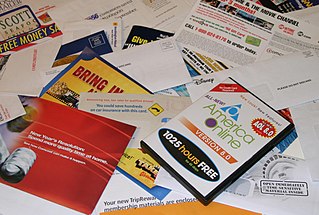
Electronic mail is a method of transmitting and receiving messages using electronic devices. It was conceived in the late–20th century as the digital version of, or counterpart to, mail. Email is a ubiquitous and very widely used communication medium; in current use, an email address is often treated as a basic and necessary part of many processes in business, commerce, government, education, entertainment, and other spheres of daily life in most countries.

Spamming is the use of messaging systems to send multiple unsolicited messages (spam) to large numbers of recipients for the purpose of commercial advertising, for the purpose of non-commercial proselytizing, for any prohibited purpose, or simply repeatedly sending the same message to the same user. While the most widely recognized form of spam is email spam, the term is applied to similar abuses in other media: instant messaging spam, Usenet newsgroup spam, Web search engine spam, spam in blogs, wiki spam, online classified ads spam, mobile phone messaging spam, Internet forum spam, junk fax transmissions, social spam, spam mobile apps, television advertising and file sharing spam. It is named after Spam, a luncheon meat, by way of a Monty Python sketch about a restaurant that has Spam in almost every dish in which Vikings annoyingly sing "Spam" repeatedly.

The mail or post is a system for physically transporting postcards, letters, and parcels. A postal service can be private or public, though many governments place restrictions on private systems. Since the mid-19th century, national postal systems have generally been established as a government monopoly, with a fee on the article prepaid. Proof of payment is usually in the form of an adhesive postage stamp, but a postage meter is also used for bulk mailing.
Various anti-spam techniques are used to prevent email spam.

Email spam, also referred to as junk email, spam mail, or simply spam, is unsolicited messages sent in bulk by email (spamming). The name comes from a Monty Python sketch in which the name of the canned pork product Spam is ubiquitous, unavoidable, and repetitive. Email spam has steadily grown since the early 1990s, and by 2014 was estimated to account for around 90% of total email traffic.

Direct marketing is a form of communicating an offer, where organizations communicate directly to a pre-selected customer and supply a method for a direct response. Among practitioners, it is also known as direct response marketing. By contrast, advertising is of a mass-message nature.

Advertising mail, also known as direct mail, junk mail, mailshot or admail, letterbox drop or letterboxing (Australia) is the delivery of advertising material to recipients of postal mail. The delivery of advertising mail forms a large and growing service for many postal services, and direct-mail marketing forms a significant portion of the direct marketing industry. Some organizations attempt to help people opt out of receiving advertising mail, in many cases motivated by a concern over its negative environmental impact.

Email fraud is intentional deception for either personal gain or to damage another individual by means of email. Almost as soon as email became widely used, it began to be used as a means to defraud people. Email fraud can take the form of a "con game", or scam. Confidence tricks tend to exploit the inherent greed and dishonesty of its victims. The prospect of a 'bargain' or 'something for nothing' can be very tempting. Email fraud, as with other 'bunco schemes,' usually targets naive individuals who put their confidence in schemes to get rich quickly. These include 'too good to be true' investments or offers to sell popular items at 'impossibly low' prices. Many people have lost their life savings due to fraud.
Email marketing is the act of sending a commercial message, typically to a group of people, using email. In its broadest sense, every email sent to a potential or current customer could be considered email marketing. It involves using email to send advertisements, request business, or solicit sales or donations. Email marketing strategies commonly seek to achieve one or more of three primary objectives, to build loyalty, trust, or brand awareness. The term usually refers to sending email messages with the purpose of enhancing a merchant's relationship with current or previous customers, encouraging customer loyalty and repeat business, acquiring new customers or convincing current customers to purchase something immediately, and sharing third-party ads.
Online advertising, also known as online marketing, Internet advertising, digital advertising or web advertising, is a form of marketing and advertising which uses the Internet to promote products and services to audiences and platform users. Online advertising includes email marketing, search engine marketing (SEM), social media marketing, many types of display advertising, and mobile advertising. Advertisements are increasingly being delivered via automated software systems operating across multiple websites, media services and platforms, known as programmatic advertising.
Cost per mille (CPM), also called cost per thousand (CPT), is a commonly-used measurement in advertising. It is the cost an advertiser pays for one thousand views or impressions of an advertisement. Radio, television, newspaper, magazine, out-of-home advertising, and online advertising can be purchased on the basis of exposing the ad to one thousand viewers or listeners. It is used in marketing as a benchmarking metric to calculate the relative cost of an advertising campaign or an ad message in a given medium.
Click-through rate (CTR) is the ratio of clicks on a specific link to the number of total users who view a page, email, or advertisement. It is commonly used to measure the success of an online advertising campaign for a particular website, as well as the effectiveness of email campaigns.
Web analytics is the measurement, collection, analysis, and reporting of web data to understand and optimize web usage. Web analytics is not just a process for measuring web traffic but can be used as a tool for business and market research and assess and improve website effectiveness. Web analytics applications can also help companies measure the results of traditional print or broadcast advertising campaigns. It can be used to estimate how traffic to a website changes after launching a new advertising campaign. Web analytics provides information about the number of visitors to a website and the number of page views, or create user behavior profiles. It helps gauge traffic and popularity trends, which is useful for market research.
Emailtracking is a method for monitoring whether the email messages is read by the intended recipient. Most tracking technologies use some form of digitally time-stamped record to reveal the exact time and date that an email was received or opened, as well as the IP address of the recipient.
Opt-in email is a term used when someone is not initially added to an emailing list and is instead given the option to join the emailing list. Typically, this is some sort of mailing list, newsletter, or advertising. Opt-out emails do not ask for permission to send emails, these emails are typically criticized as unsolicited bulk emails, better known as spam.
HTML email is the use of a subset of HTML to provide formatting and semantic markup capabilities in email that are not available with plain text: Text can be linked without displaying a URL, or breaking long URLs into multiple pieces. Text is wrapped to fit the width of the viewing window, rather than uniformly breaking each line at 78 characters. It allows in-line inclusion of images, tables, as well as diagrams or mathematical formulae as images, which are otherwise difficult to convey.

Content marketing is a form of marketing focused on creating, publishing, and distributing content for a targeted audience online. It is often used by businesses in order to achieve the following goals: attract attention and generate leads, expand their customer base, generate or increase online sales, increase brand awareness or credibility, and engage an online community of users. Content marketing attracts new customers by creating and sharing valuable free content. It helps companies create sustainable brand loyalty, provides valuable information to consumers, and creates a willingness to purchase products from the company in the future.
Video email, also referred to as email video or video in email, refers to the embedding of videos directly into the body of an email, without the need to attach files or click on a hyperlink to play them. Although video email providers have existed since the early-to-mid 2000s, it has become an increasingly popular medium for email marketing in recent years due to technological advancements, and is used to boost engagement rates. Several companies use video email to showcase their brand identity, send out newsletters, and announce events, product lines or launches.
In electronic commerce, conversion marketing is marketing with the intention of increasing conversions—that is, site visitors who are paying customers.
Spy pixels or tracker pixels are hyperlinks to remote image files in HTML email messages that have the effect of spying on the person reading the email if the image is downloaded. They are commonly embedded in the HTML of an email as small, imperceptible, transparent graphic files. Spy pixels are commonly used in marketing, and there are several countermeasures in place that aim to block email tracking pixels. However, there are few regulations in place that effectively guard against email tracking approaches.